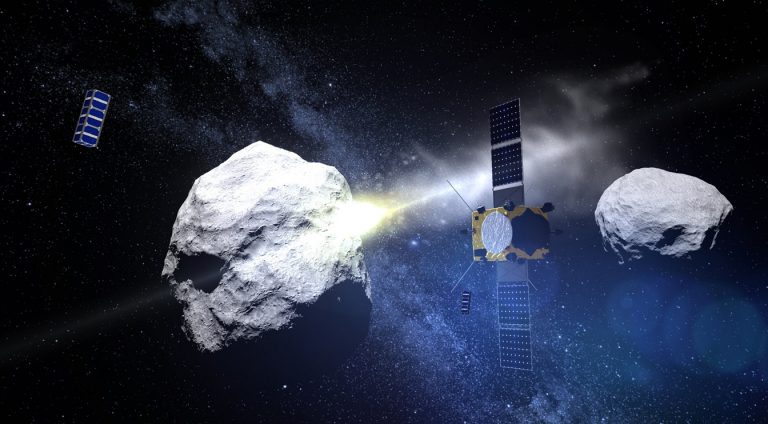NASA hits an asteroid in October 2022 to test planetary defense

Almost every day small asteroids fly to Earth. Most of them do not reach the surface, disintegrate in the upper layers of the atmosphere and burn. Only large asteroids, which are much rarer, can hit the surface. According to experts, to cause a global effect for the entire terrestrial ecosystem, an asteroid must have a diameter of more than 1 km. What to do if an asteroid of this size goes to Earth?
To prevent a catastrophe, NASA tracks potentially dangerous asteroids, whose orbits pass near the Earth. As reported, about 93% of such objects have already been entered into the database.
At the same time, NASA is working on a DART (Double Asteroid Redirection Test) program to reject the asteroid's trajectory. To begin with, technology will be tested on a medium-sized asteroid, which can lead not to a global, but only to a regional catastrophe on Earth.
Last year, NASA created the Planetary Defense Coordination Office (PDCO) to assess and create asteroid impact protection. It is engaged in the search and cataloging of asteroids and comets, which will fly past the Earth and carry potential danger. This bureau will issue warnings to the inhabitants of the Earth about a possible collision, and it will plan and coordinate with the US government the operation to reject the asteroid.
DART is an experiment, how realistic is it to perform such an operation and reject a medium-sized asteroid. For the test, they will choose a cosmic body, which does not really threaten the Earth, but whose trajectory can be measured and verified whether the plan will work in case of a real threat.
Until recently, the project existed only in the form of a concept, but on June 23, 2017, the leadership of NASA approved the concept and allowed to proceed to the next phase - preliminary design.
“DART will be NASA’s first mission to demonstrate what is known as a kinetic impact technique — hitting an asteroid to move its orbit,” said Lindley Johnson, a planetary defense officer at NASA headquarters in Washington. “The current approval is moving the project closer to the historical test of a small asteroid that does not threaten Earth.”
The target for the DART strike will be an asteroid, which will fly at a distance of 10.9 million km from Earth in October 2022. This is a double asteroid Didymos, which consists of two bodies: Didymos A with a size of about 780 m and Didymos B with a size of about 160 m. A DART probe will strike the smaller one.
The Didymos system has been carefully studied since 2003. The largest of the asteroids, Didymos A, is a stone (silicon) asteroid of class S, it is the second most common class of asteroids after carbon, it is 17% of all known asteroids. The composition of its small twin Didymos B is still unknown.
The small asteroid Didymos B revolves around Didymos A. This facilitates the analysis of the test results - you can immediately see how its trajectory has changed and what the impact vector was, but we guarantee that the trajectory of the binary system around the Sun will not change, and certainly not they will leave their route and will not suddenly head in the direction of the Earth as a result of an experiment.
A DART spacecraft about the size of a refrigerator will fly up to the Didymos dual system, and then the automatic guidance system will send it to the Didymos B body at a speed of about 6 km / s. As NASA writes, it is nine times faster than a bullet. Earth observatories will closely observe the collision and evaluate the effect.
It is enough to change the trajectory of the cosmic body just a tiny fraction of a degree, if it is far enough from the Earth. It is very important to detect the threat in advance and send the device in advance for kinetic effects. The further the impact from the Earth is made, the weaker the impact is required to divert the asteroid from the course to the Earth. However, much depends here not only on the composition of the asteroid and its mass, but also on its internal structure. A real experiment with a strike on a 160-meter asteroid will allow to answer many questions, scientists believe. He will help in the preparation of another mission to transfer some valuable asteroid into orbit around the moon. This mission of the Asteroid Redirect Mission is also scheduled for 2020-2030.
Initially, the DART project was created as part of the Asteroid Impact and Deflection Assessment (AIDA) initiative, jointly with the European Space Agency (ESA). For its part, the ESA was supposed to develop a descent module, which would land on the surface of Didymos B before it was struck by DART, in order to capture accurate seismic data and transmit to Earth. Now the future of the European part of the project is questionable, but NASA has decided to continue the tests without a descent module. Time does not wait: the Didymos double system will fly around us in October 2022, and you need to launch DART in 2020 to meet with it.
Since 2014, NASA has been holding Asteroid Day annual events, in which it tells the general public about asteroids. Festivals are held on June 30 - it was on this day in 1908 that the 122-meter-long Tungussky meteorite fell to the ground. The collision energy was 15 megatons, and the blast wave destroyed 2,000 km² of forest.
All Articles